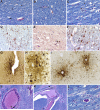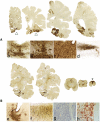Military-related traumatic brain injury and neurodegeneration
- PMID: 24924675
- PMCID: PMC4255273
- DOI: 10.1016/j.jalz.2014.04.003
Military-related traumatic brain injury and neurodegeneration
Abstract
Mild traumatic brain injury (mTBI) includes concussion, subconcussion, and most exposures to explosive blast from improvised explosive devices. mTBI is the most common traumatic brain injury affecting military personnel; however, it is the most difficult to diagnose and the least well understood. It is also recognized that some mTBIs have persistent, and sometimes progressive, long-term debilitating effects. Increasing evidence suggests that a single traumatic brain injury can produce long-term gray and white matter atrophy, precipitate or accelerate age-related neurodegeneration, and increase the risk of developing Alzheimer's disease, Parkinson's disease, and motor neuron disease. In addition, repetitive mTBIs can provoke the development of a tauopathy, chronic traumatic encephalopathy. We found early changes of chronic traumatic encephalopathy in four young veterans of the Iraq and Afghanistan conflict who were exposed to explosive blast and in another young veteran who was repetitively concussed. Four of the five veterans with early-stage chronic traumatic encephalopathy were also diagnosed with posttraumatic stress disorder. Advanced chronic traumatic encephalopathy has been found in veterans who experienced repetitive neurotrauma while in service and in others who were accomplished athletes. Clinically, chronic traumatic encephalopathy is associated with behavioral changes, executive dysfunction, memory loss, and cognitive impairments that begin insidiously and progress slowly over decades. Pathologically, chronic traumatic encephalopathy produces atrophy of the frontal and temporal lobes, thalamus, and hypothalamus; septal abnormalities; and abnormal deposits of hyperphosphorylated tau as neurofibrillary tangles and disordered neurites throughout the brain. The incidence and prevalence of chronic traumatic encephalopathy and the genetic risk factors critical to its development are currently unknown. Chronic traumatic encephalopathy has clinical and pathological features that overlap with postconcussion syndrome and posttraumatic stress disorder, suggesting that the three disorders might share some biological underpinnings.
Keywords: Alzheimer's disease; Chronic traumatic encephalopathy; Neurodegeneration; TDP-43; Tauopathy; Traumatic brain injury; Veterans.
Copyright © 2014. Published by Elsevier Inc.
Figures


References
-
- Wojcik BE, Stein CR, Bagg K, Humphrey RJ, Orosco J. Traumatic brain injury hospitalizations of U.S. army soldiers deployed to Afghanistan and Iraq. Am J Prev Med. 2010;38(1 suppl):S108–16. - PubMed
-
- Hoge CW, McGurk D, Thomas JL, Cox AL, Engel CC, Castro CA. Mild traumatic brain injury in U.S. Soldiers returning from Iraq. N Engl J Med. 2008;358:453–63. - PubMed
-
- Bell RS, Vo AH, Neal CJ, Tigno J, Roberts R, Mossop C, et al. Military traumatic brain and spinal column injury: a 5-year study of the impact blast and other military grade weaponry on the central nervous system. J Trauma. 2009;66(4 suppl):S104–11. - PubMed
-
- Terrio H, Brenner LA, Ivins BJ, Cho JM, Helmick K, Schwab K, et al. Traumatic brain injury screening: Preliminary findings in a US Army Brigade Combat Team. J Head Trauma Rehabil. 2009;24:14–23. - PubMed
-
- Mott FW. The effects of high explosives upon the central nervous system, lecture I. Lancet. 1916;48:331–8.
Publication types
MeSH terms
Grants and funding
LinkOut - more resources
Full Text Sources
Other Literature Sources
Medical
Research Materials

